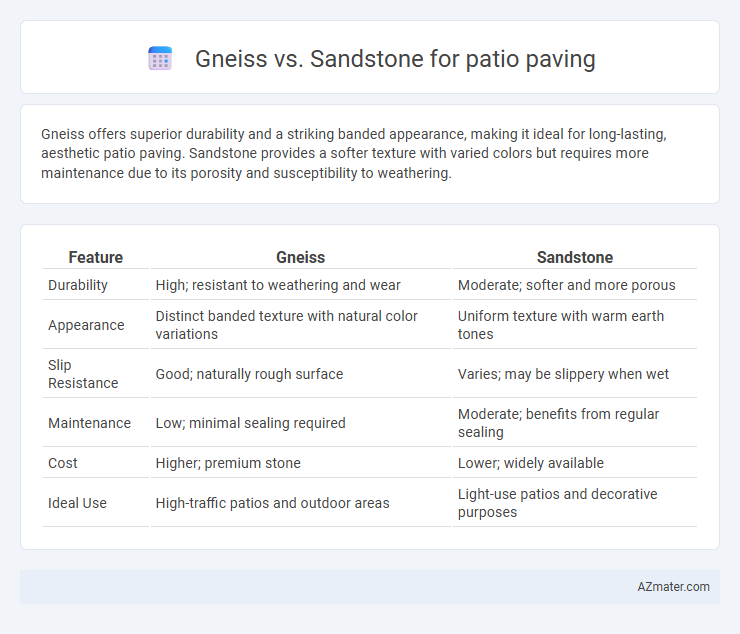Gneiss offers superior durability and a striking banded appearance, making it ideal for long-lasting, aesthetic patio paving. Sandstone provides a softer texture with varied colors but requires more maintenance due to its porosity and susceptibility to weathering.
Table of Comparison
| Feature | Gneiss | Sandstone |
|---|---|---|
| Durability | High; resistant to weathering and wear | Moderate; softer and more porous |
| Appearance | Distinct banded texture with natural color variations | Uniform texture with warm earth tones |
| Slip Resistance | Good; naturally rough surface | Varies; may be slippery when wet |
| Maintenance | Low; minimal sealing required | Moderate; benefits from regular sealing |
| Cost | Higher; premium stone | Lower; widely available |
| Ideal Use | High-traffic patios and outdoor areas | Light-use patios and decorative purposes |
Introduction to Gneiss and Sandstone Patio Paving
Gneiss is a durable metamorphic rock characterized by its banded texture and high resistance to weathering, making it an excellent choice for patio paving where longevity and natural aesthetics are desired. Sandstone, a sedimentary rock composed mainly of quartz and feldspar, offers a softer texture and warm earth tones, providing a slip-resistant surface ideal for outdoor patios. Both materials vary in hardness and porosity, impacting maintenance needs and suitability depending on climate and design preferences.
Geological Composition and Formation
Gneiss, a metamorphic rock characterized by its high-grade foliation and mineral banding, forms through the intense heat and pressure that re-crystallize granite or sedimentary rock, resulting in a durable, dense structure ideal for patio paving. Sandstone, a sedimentary rock composed mainly of compacted sand-sized quartz and feldspar grains, forms from the gradual cementation of sediment deposits, offering a porous texture and varied color range but generally lower strength compared to gneiss. The crystalline structure of gneiss lends superior resistance to weathering and mechanical stress, while sandstone's granular composition provides easier cutting and shaping but requires more maintenance to prevent erosion and staining.
Aesthetic Appeal: Colors and Textures
Gneiss offers a distinctive aesthetic appeal for patio paving with its banded layers and rich, natural colors ranging from gray and pink to tan, providing a striking, textured surface. Sandstone presents a warm, earthy palette featuring shades of tan, red, and yellow, characterized by a fine-grained texture that creates a smooth, uniform look. Both materials provide unique visual interest, with Gneiss emphasizing dramatic contrast and texture, while Sandstone appeals through subtle color variations and consistent surface patterns.
Durability and Weather Resistance
Gneiss offers superior durability and weather resistance compared to sandstone, making it ideal for patio paving in harsh climates. Its tightly interlocking mineral grains provide exceptional strength and resistance to erosion, while sandstone, being softer and more porous, is prone to weathering and surface wear over time. Gneiss withstands freeze-thaw cycles and heavy foot traffic better, ensuring a longer-lasting, low-maintenance patio surface.
Slip Resistance and Surface Finish
Gneiss offers superior slip resistance for patio paving due to its coarse, foliated texture that provides natural traction, making it safer in wet conditions compared to sandstone. Sandstone typically has a smoother surface finish that can become slippery when wet, requiring additional treatments or texturing to enhance grip. The durability and roughness of gneiss make it an ideal choice for outdoor areas where slip resistance is a critical factor.
Maintenance Requirements and Longevity
Gneiss offers superior durability and low maintenance for patio paving due to its high resistance to weathering and natural wear, making it ideal for long-term outdoor use. Sandstone, while aesthetically pleasing with its natural texture, requires regular sealing and more frequent upkeep to protect against staining and erosion. Over time, gneiss maintains structural integrity better than sandstone, ensuring a longer lifespan with minimal maintenance efforts.
Installation Process and Ease of Handling
Gneiss and sandstone differ significantly in their installation process and ease of handling for patio paving due to their physical properties. Gneiss, being a harder and denser metamorphic rock, requires specialized cutting tools and more effort during installation but offers superior durability and resistance to wear. Sandstone's softer, sedimentary composition allows for easier cutting, shaping, and quicker installation, making it a preferred choice for DIY projects, though it may require more maintenance over time to prevent erosion and weathering.
Environmental Impact and Sustainability
Gneiss and sandstone both offer durable options for patio paving, but gneiss has a lower environmental impact due to its natural abundance and minimal processing requirements, resulting in reduced carbon emissions. Sandstone extraction often involves more intensive quarrying techniques that can lead to greater habitat disruption and higher energy consumption. Selecting gneiss supports sustainability by promoting resource efficiency and longevity, reducing the need for frequent replacements.
Cost Comparison and Value for Money
Gneiss offers greater durability and natural resistance to weathering compared to sandstone, often resulting in higher upfront costs but longer lifespan, making it a cost-effective choice over time. Sandstone typically presents a lower initial price point and a wide variety of colors and textures, but it may require more maintenance and sealing to prevent erosion and staining. Evaluating long-term expenses including installation, upkeep, and replacement frequency positions gneiss as a better value for money for patio paving projects demanding longevity and minimal maintenance.
Final Verdict: Choosing the Best Stone for Your Patio
Gneiss offers superior durability and a unique, banded appearance that enhances patio aesthetics, making it ideal for high-traffic areas and long-term use. Sandstone provides a softer texture and warmer tones, creating a natural and inviting outdoor space, but it requires more maintenance due to its porous nature. For longevity and strength, gneiss is the best choice, while sandstone suits designs prioritizing comfort and organic charm.

Infographic: Gneiss vs Sandstone for Patio paving
 azmater.com
azmater.com